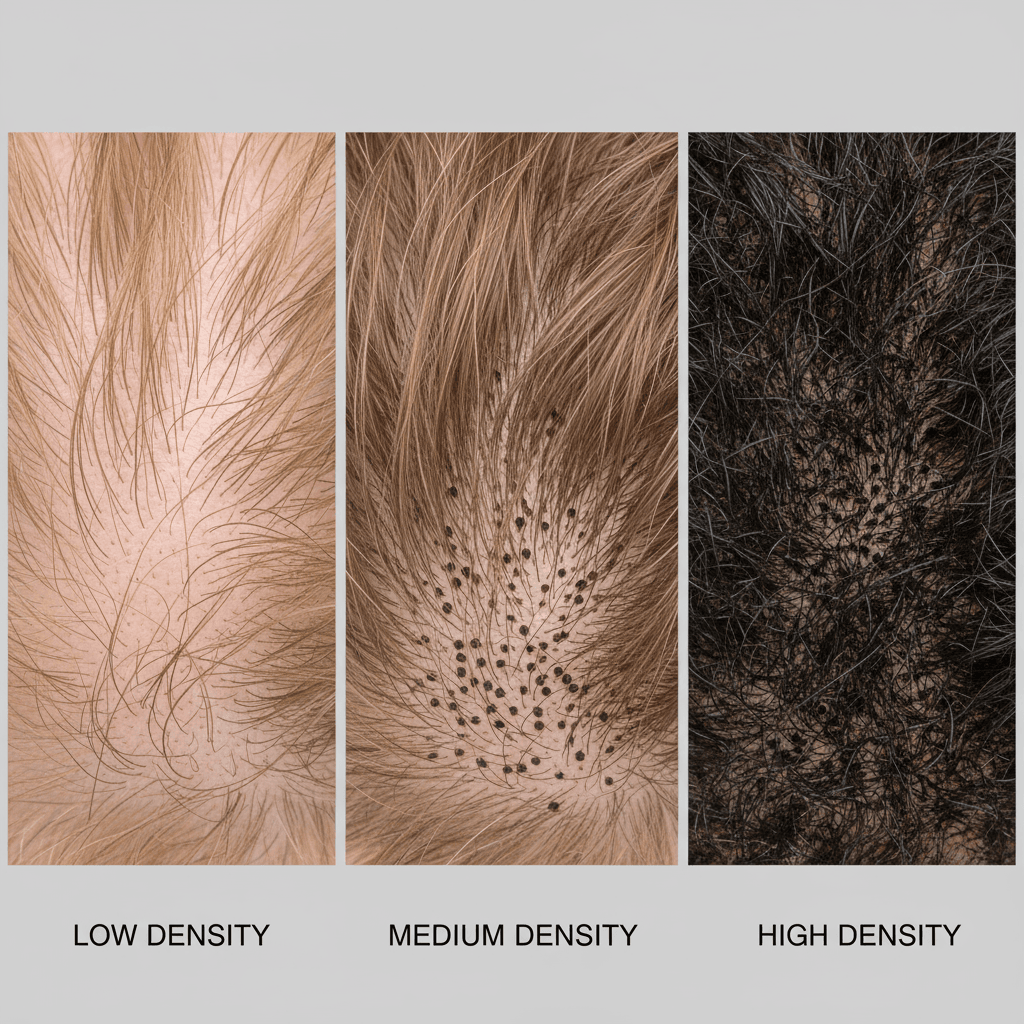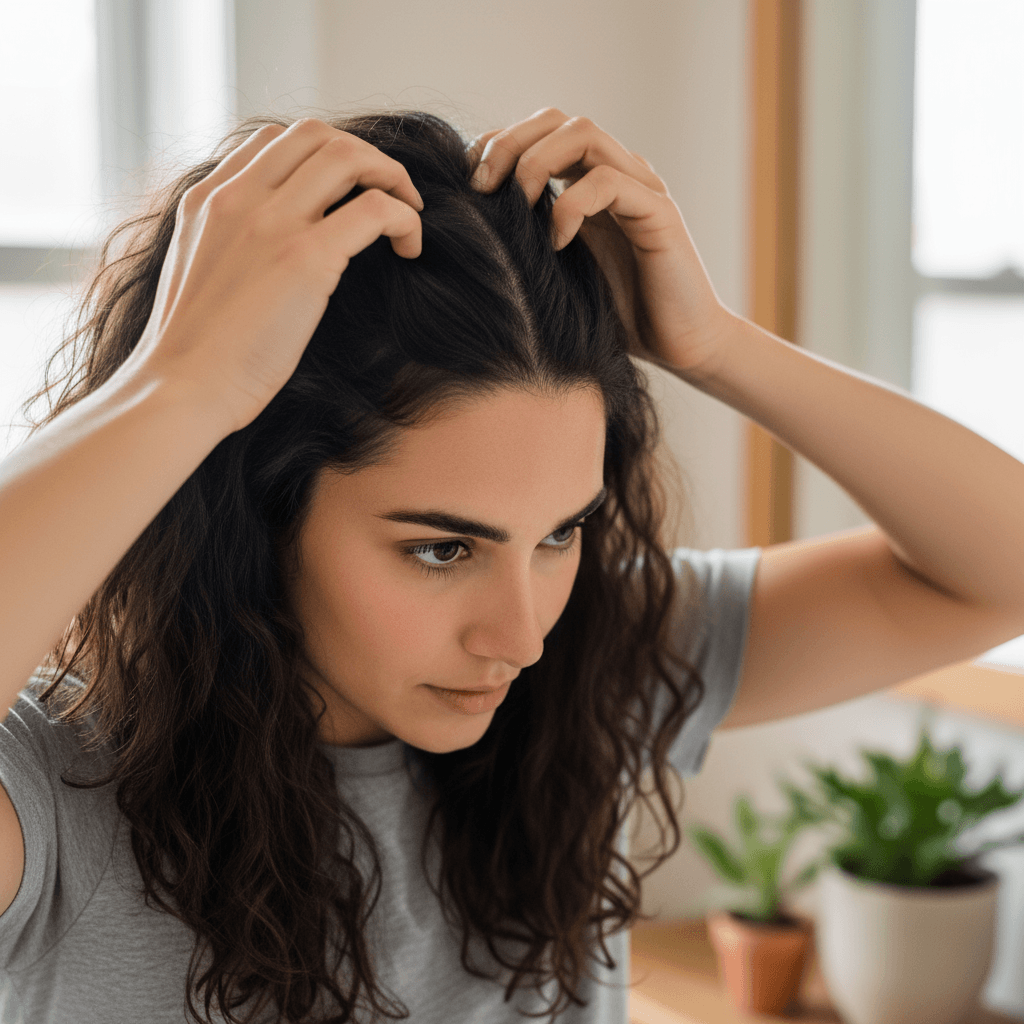Hair density directly determines how full and voluminous your hair appears, making it one of the most sought-after hair characteristics. While genetics play a significant role in determining your natural hair density, scientific research shows that specific techniques, treatments, and lifestyle changes can effectively increase the appearance and actual thickness of your hair strands.
Understanding Hair Density: The Science Behind Fuller Hair
Hair density refers to the number of individual hair follicles per square inch of your scalp, typically ranging from 80 to 200 strands per square inch. This measurement differs significantly from hair thickness (the diameter of individual strands) and directly impacts your hair’s overall volume and appearance.
Types of Hair Density

Low Density Hair (Under 80 strands/sq inch)
- Scalp is easily visible through hair
- Hair appears thin and lacks volume
- Styling products tend to weigh hair down
Medium Density Hair (80-120 strands/sq inch)
- Moderate scalp visibility
- Balanced volume and manageability
- Most common hair density type
High Density Hair (120+ strands/sq inch)
- Minimal scalp visibility
- Naturally voluminous appearance
- May require specialized styling techniques
Factors That Affect Hair Density
Genetic Factors
Your genetic blueprint determines approximately 80% of your hair characteristics, including follicle count, hair growth cycle duration, and individual strand thickness. While you cannot change your genetic predisposition, understanding it helps set realistic expectations for density improvement.
Hormonal Influences
Hormones significantly impact hair density through various mechanisms:
- Androgens: DHT (dihydrotestosterone) can miniaturize hair follicles, reducing density
- Estrogen: Promotes hair growth and maintains follicle health
- Thyroid hormones: Regulate hair growth cycles and strand strength
- Cortisol: Chronic elevation disrupts normal hair growth patterns
Nutritional Deficiencies
Research indicates that specific nutrient deficiencies directly correlate with reduced hair density:
- Iron deficiency: Affects oxygen transport to follicles
- Protein insufficiency: Reduces keratin production
- Vitamin D deficiency: Impairs follicle cycling
- B-vitamin deficiencies: Compromise cellular energy production
How To Measure Your Hair Density Accurately
Professional Assessment Methods
Trichoscopy Analysis
Dermatologists use specialized equipment to count follicles per square centimeter, providing precise density measurements and identifying miniaturized follicles.
Pull Test Evaluation
A standardized test where approximately 60 hairs are gently pulled to assess shedding patterns and follicle strength.
At-Home Assessment Techniques
Scalp Visibility Method
Part your hair in multiple sections under bright lighting. If you can easily see your scalp without manipulation, you likely have low to medium density.
Ponytail Circumference Test
Measure your ponytail’s circumference at the base:
- Less than 2 inches: Low density
- 2-3 inches: Medium density
- Over 3 inches: High density
Strand Count Analysis
Using a 1-inch square template, count visible hair strands in different scalp areas for an average density estimate.
Evidence-Based Methods To Increase Hair Density
Scalp Stimulation Techniques
Mechanical Stimulation
Regular scalp massage increases blood circulation by up to 69%, according to research published in the Journal of Physical Therapy Science. Enhanced circulation delivers essential nutrients and oxygen to hair follicles.
Recommended technique: Use fingertips to apply gentle pressure in circular motions for 5-10 minutes daily.
Microneedling Therapy
Studies show that microneedling combined with minoxidil increases hair count by 91% compared to minoxidil alone. The process creates micro-injuries that stimulate growth factors and improve product absorption.
Nutritional Optimization Strategies
Protein Intake Enhancement
Hair is approximately 95% protein (keratin). Research indicates that increasing protein intake to 1.2-1.6 grams per kilogram of body weight supports optimal hair growth.
Key protein sources:
- Lean meats and poultry
- Fish and seafood
- Legumes and quinoa
- Greek yogurt and cottage cheese
Essential Vitamin Supplementation
Clinical trials demonstrate specific vitamins’ effectiveness in improving hair density:
- Biotin (5,000-10,000 mcg daily): Increases hair thickness by 25%
- Iron (18-30mg daily for deficient individuals): Restores normal growth cycles
- Vitamin D3 (2,000-4,000 IU daily): Activates dormant follicles
- Omega-3 fatty acids (1,000-2,000mg daily): Reduces inflammation and supports follicle health
| Supplement | Key Ingredients / Benefits | Approx Price* |
|---|---|---|
| HealthKart Biotin 10,000 mcg (90 tablets) | High biotin dose, helps hair, skin, nails | ~ ₹449 |
| Carbamide Forte Biotin with Multivitamin, Keratin & Bamboo Extract | Biotin + keratin etc., for more strength and less breakage | ~ ₹479 for 90 tablets |
| Bold Care Biotin Hair Regrowth Tablets (60 tablets) | Vegetarian, gluten-free, provides support for hair growth. | ~ ₹899 |
Topical Treatment Applications
Minoxidil Therapy
FDA-approved minoxidil increases hair density by extending the anagen (growth) phase and enlarging miniaturized follicles. Studies show 5% minoxidil produces superior results compared to 2% formulations.
Natural Growth Stimulants
Research supports several natural compounds for density enhancement:
- Rosemary oil: Equally effective as 2% minoxidil in clinical trials
- Pumpkin seed oil: Increases hair count by 40% after 24 weeks
- Caffeine: Stimulates follicles and counteracts DHT effects
- Adenosine: Prolongs anagen phase and increases hair thickness
Advanced Treatment Options
Low-Level Laser Therapy (LLLT)
FDA-cleared laser devices increase hair density through photobiomodulation, stimulating cellular energy production in follicles. Clinical studies report 35% increase in hair density after 16 weeks of treatment.
Platelet-Rich Plasma (PRP)
PRP treatments involve injecting concentrated growth factors from your own blood into the scalp. Research shows 25-30% improvement in hair density after 3-4 sessions.
Hair Transplantation
For significant density loss, follicular unit extraction (FUE) or follicular unit transplantation (FUT) can permanently relocate healthy follicles to thinning areas.
Lifestyle Modifications for Optimal Hair Density

Stress Management
Chronic stress elevates cortisol levels, disrupting hair growth cycles and reducing density. Implement stress-reduction techniques:
- Regular meditation or mindfulness practice
- Adequate sleep (7-9 hours nightly)
- Regular physical exercise
- Professional counseling when needed
Hair Care Best Practices
Gentle Handling Techniques
- Use wide-tooth combs on wet hair
- Avoid tight hairstyles that create tension
- Sleep on silk or satin pillowcases
- Pat hair dry instead of aggressive towel rubbing
Product Selection Guidelines
Choose hair care products specifically formulated for density enhancement:
- Sulfate-free shampoos to prevent stripping
- Volumizing conditioners applied to mid-lengths and ends only
- Leave-in treatments containing growth-promoting ingredients
- Heat protectants for styling tool use
Environmental Protection
Protect hair from density-damaging environmental factors:
- UV radiation exposure
- Chlorine and salt water
- Pollution and free radicals
- Extreme temperature fluctuations
Common Mistakes That Reduce Hair Density
Over-Processing Damage
Chemical treatments like bleaching, perming, and frequent coloring weaken hair structure and can damage follicles, leading to reduced density over time.
Nutritional Extremes
Both restrictive dieting and excessive supplementation can negatively impact hair growth. Maintain balanced nutrition without dramatic restrictions.
Aggressive Styling Practices
Frequent use of high-heat styling tools, tight hairstyles, and harsh brushing can cause mechanical damage and follicle trauma.
Ignoring Underlying Health Issues
Conditions like thyroid disorders, PCOS, and autoimmune diseases can significantly impact hair density. Address health concerns with medical professionals.
Creating Your Personalized Hair Density Plan
Assessment Phase (Weeks 1-2)
- Document current density using measurement techniques
- Identify potential contributing factors
- Establish baseline photographs
- Consider professional consultation
Implementation Phase (Months 1-3)
- Begin chosen treatment protocols
- Implement nutritional improvements
- Establish consistent hair care routine
- Monitor progress with monthly assessments
Optimization Phase (Months 4-6)
- Adjust treatments based on results
- Add advanced therapies if needed
- Fine-tune nutrition and supplementation
- Continue consistent monitoring
Maintenance Phase (Ongoing)
- Maintain successful protocols
- Regular professional assessments
- Adapt treatments as needed
- Focus on long-term hair health
The Modern Womanly Recommends Haircare Products For Hair Density
| Product | What It Does | Approx Price* |
|---|---|---|
| Tugain Men 5% Minoxidil (60 ml solution) | A widely used topical to stimulate hair regrowth | ~ ₹715 (Pharmeasy) (PharmEasy) |
| Bold Care Minoxidil 5% Topical Solution | Topical for hair regrowth and to reduce hairfall | ~ ₹1,649 for 3 × 60 ml (~180 ml) pack. (Flipkart) |
| Morr 5% Minoxidil (60 ml) | Another generic topical minoxidil | ~ ₹659 (Amazon India) |
| Mintop Forte 5% Minoxidil Solution (Dr. Reddy’s, 60 ml) | Same class; known brand in India | ~ ₹974 (Rengas Pharmacy) |
| Tata 1mg Minoxidil 5% Solution | Generic/house brand type; more budget-friendly | ~ ₹549 (discounted) (Rengas Pharmacy) |
| Mx-F 5% Minoxidil + Finasteride Solution | Combination treatment — minoxidil + finasteride (stronger prescription needed) | ~ ₹700-₹800 for 60 ml bottle. (Amazon India) |
Expected Timeline for Hair Density Improvements
Hair growth occurs in cycles, making patience essential for seeing results:
Month 1-2: Reduced shedding and improved hair health
Month 3-4: Initial density improvements become visible
Month 6-8: Significant density increases apparent
Month 12+: Maximum results achieved with continued maintenance
Professional Treatment Considerations
When to Seek Professional Help
Consider consulting a trichologist or dermatologist if you experience:
- Sudden or rapid hair density loss
- Patchy areas of thinning
- Scalp irritation or inflammation
- No improvement after 6 months of consistent treatment
Treatment Selection Criteria
Professional treatments should be selected based on:
- Severity of density loss
- Underlying causes
- Age and health status
- Budget and time constraints
- Realistic outcome expectations
Conclusion
Achieving increased hair density requires a multifaceted approach combining scientifically-proven treatments, proper nutrition, gentle care practices, and patience. By understanding the factors that influence hair density and implementing evidence-based strategies, you can significantly improve your hair’s fullness and overall health. Remember that consistency is key, and results improve over time with dedicated care and appropriate treatment selection.
Frequently Asked Questions
While you cannot create new follicles, you can significantly improve the thickness and health of existing hairs, creating the appearance of increased density. Some advanced treatments like hair transplantation can provide permanent density improvements.
Most people begin noticing improvements within 3-4 months of consistent treatment. Significant changes typically become apparent after 6-8 months due to the hair growth cycle.
Natural methods can provide meaningful improvements, especially for mild density concerns. However, medical treatments like minoxidil and laser therapy generally produce more dramatic results for significant density loss.
Yes, hair density naturally decreases with age due to hormonal changes, reduced cellular function, and cumulative environmental damage. However, proper care can significantly slow this process.
Yes, though it may require more intensive treatment approaches due to hormonal changes. Combining multiple strategies often yields the best results for post-menopausal women.
Quality supplements addressing specific deficiencies can improve hair density, but they work best as part of a comprehensive approach rather than standalone treatments.
While stress can significantly reduce hair density, the effects are typically reversible once stress levels are managed and proper treatment is implemented.



